
Best of 2025 LearnOps Webinars
A curated, on-demand path for L&D and Talent leaders to modernize budgets, operations, and strategy using LearnOps. This webinar collection brings together leading CLOs, industry
Book a demo to see how you can streamline LearnOps, make data-driven budget decisions, and measure the ROI of your learning programs – all in one platform.

Designing corporate training takes a lot of time. From managing training projects to instructional design to working with SMEs, training teams are often under pressure and underresourced.
But that’s not to say that things haven’t picked up for L&D in recent years. The learning technology sector is snowballing. Increasingly sophisticated tools are available to help training teams collaborate, streamline instructional design, and deliver incredible elearning products to employees.
And yet, there are still lots of processes in corporate training design that are far from perfect. In fact, some barely get a mention in between all the fuss about choosing an LMS or authoring tool.
Training intake and the management of training requests is one of those processes.
Many L&D teams view training requests as an interruption they could do without. They’re often misguided, and it takes precious resources from an already time-starved training team to deal with them.
But a properly streamlined strategic training intake process has the potential to amplify all your other training design efforts. So you can leverage the process to provide value to your team rather than taking up resources.
On this page, you’ll find everything you need to know about training requests and training intake processes. You’ll learn how to better manage, prioritize, and process training requests in your organization for greater training success.
Training intake is the process of receiving, assessing, prioritizing, and managing training requests. During training intake, corporate learning teams receive the requests and decide which action to take. This action could be moving forward to new course design, declining the request for various reasons, or directing the requester towards other resources.
A training request is any form of request for learning or training submitted to the learning and development team by any employee, manager, or stakeholder. They can take any form, including formal submissions through an established intake process, emails, instant messenger, in-person requests, phone calls, or any other informal communication during which a request for training is made.
Training requests are submissions made by employees, managers, and stakeholders to the training development team. Training intake is the process by which the training department receives, manages, and processes training requests, whether they are eventually accepted or declined.

Nothing kills the effectiveness of a process faster than informality. And “informal” is often the word used to describe training intake processes currently widely used by L&D. Requests for training come to the learning team in many different formats. But receiving requests through email, instant messenger, and in person is costing you precious time and resources.
On Demand Webinar
In this recording, you’ll learn how crowdsourcing can be applied to corporate training to lighten the load of training requests and help you keep up with the demand for training.
Without a formal process, L&D are open to receiving training requests for whatever pops into a stakeholder’s head. Formalizing the process means creating standardized request forms. Training teams can then take control of the conversation from the start. This also means avoiding requests that don’t align with the business performance or corporate strategy.
By allowing requests to flow in through multiple channels, chances are higher for valid requests to fall through the cracks. But by using a formal process, employees feel reassured that the corporate training team will respond in due course.
Multiple communication channels also make it difficult for L&D to maintain clear oversight into training demand. How can you know how many requests you’re dealing with if half of them are sitting in your teams’ inboxes? Crowdsourcing training intake through a formal process gives you better visibility into training request volumes at all times.
Many corporate training teams are currently not tracking their training intake data at all. And those that are monitoring training requests are only gaining basic insights. Informal processes make it challenging to collect information in a consistent and organized way. So when the time comes to assess training demand, L&D have very little consistent data to use.
If you only do one thing for your training intake process, create and implement a standardized training request form. The form can come in all different types of formats. You can distribute it wherever you think is appropriate for your organization.
Standardized forms take a lot of the guessing out of training requests. And that’s not just for the training team, but for employees as well.

With a formal training request form, the action L&D should take from the request is more instantly apparent. So you’ll cut down on email chains and meetings to discuss requests.
Strategic questions can indicate to employees whether or not their request is likely to be accepted. You may be able to surface alternatives that make more sense than waiting for L&D to build a new course. This also helps to cut down on training request volumes and time spent corresponding with stakeholders.
Informal requests often involve going back and forth with the requester. You spend time scoping out the request and gathering requirements. And this process is doubly time-consuming through face-to-face meetings. A standardized form allows you to ask those questions straight off the bat, saving you a lot of time.
Capturing the right information on your form makes it much easier to prioritize the requests once you accept them. Frame the questions so that requests are much easier to quickly accept or decline depending on the answers.
Sometimes, you get everything you need from a training request form to move quickly into course design. But even if you need further communication for more complex requests, gathering the right information on the form sets you up for a more productive follow-up conversation.
The key to great analytics is consistent and standardized data collection. Asking the right questions on your form and mantaining a standard approach provides data. L&D can then gain insights into training demand in the organization.
Download this ebook to see how crowdsourcing can be applied to corporate training to lighten
the load of training requests and help you keep up with the demand for training.

So, how should this training request form look? And what questions should you include?
Firstly, let’s break the form into sections:


Regardless of whether all employees or only management can submit training requests, it’s crucial to capture essential details.
This section will enable you to quickly identify important strategic requests from senior or executive level management.
This section helps to scope out the intended topic. You’ll also learn what the requester hopes to gain from the training.
Include question guidance for this section. It will help the requester provide you with full answers and enough detail.
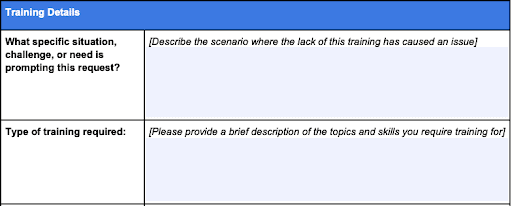
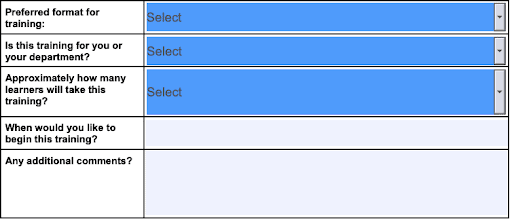
Standardize the answers wherever possible. For example, use dropdowns or multiple choice style questions in the form.
The information you gather here will give an indication of the resources you’ll need to fulfill the request. Examples of other questions you might like to include in this section are:
The more you ask on the form, the better prepared you’ll be for course design, prioritizing the request, or any follow-up conversations needed with the requester.

As with all business functions, L&D need to prioritize activities that impact the bottom line. Including questions that explore this on the form allows you to better prioritize training requests accordingly.
It might seem like a lot of information, but every question serves a vital purpose.
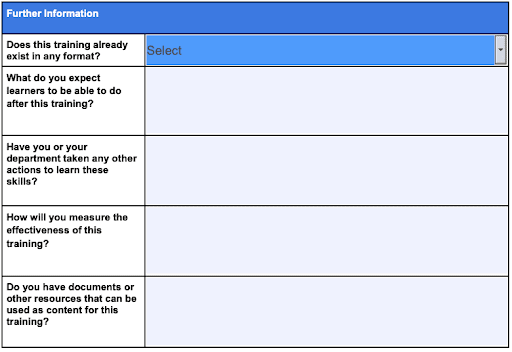
Does this training already exist in any format?
You can also take this opportunity to try and exclude misguided training requests immediately. For example, maybe the requester didn’t think of checking if training already exists. This question may encourage them to double-check before submitting a request, so you’ll save everyone some time.
What do you expect learners to be able to do after this training?
Learning objectives will practically be writing themselves! These questions are also helping to clarify what the learner hopes to gain.
Have you taken any other actions to learn these skills?
If the organization already provided training repeatedly for this particular topic or skill, chances are that training isn’t the answer. It may be an indication of a performance issue rather than a training need.
How will you measure the effectiveness of this training?
A question like this is the perfect opportunity to tie training efforts directly to business outcomes. Plus, it means the course that you spend time and resources developing won’t fall into a black hole after deployment.
Do you have documents or other resources that we can use as content for this training?
Earning quick wins for your training team can be as simple as identifying and prioritizing requests where the content you need already exists, so you can easily crowdsource learning.

As you start to create questions for your request form, you’ll see how you can capture data to frame the request in terms of strategic business importance. So the questions can also provide early insight into the instructional design needs for a potential course.
Examples of other questions you could ask in this section of the training request form include:
Top Tip: Create multiple training request forms according to different use cases that are typical
to various departments. For example, sales enablement, compliance, or safety training.
Depending on your size and budget, you may rely a lot on external training solutions to fulfill different needs.
Business functions also often have departmental training budgets to provide external training for scenarios when L&D cannot fulfill a training need.
However, it’s still advisable for the corporate learning team to have oversight on external training facilitators. L&D will be better able to assess the quality of training provided and how closely it fits the need.
So you may want to create separate training request forms for external training solutions. That way, L&D still retains full visibility into all learning taking place across the organization. Plus, you can collect the information you need about potential external learning providers.
Save time and capture all the information you need with this free downloadable template.
Choose between a customizable Word document or a fillable PDF!

There are plenty of online form building tools available. Lots of them are free but with limited functionality. So, whether you just want something that gets the job done or you have some budget to spare for a more valuable paid platform, you’ll be creating sophisticated training request forms in no time.
Here are just a few of the tools you can try out for building online training intake forms.

A handy online tool. Create an unlimited amount of forms, brand the form with your logo and leverage a decent variety of question types.
You can share the form via email, with a link, or embed it on a web page.
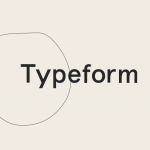
This is a great option if the styling and branding of your form are of high importance to you. It’s also very user-friendly with plenty of in-app guidance to help you through the form building process.
However, distributing your completed form through Typeform is a little more complicated than other options beyond a simple share link.

Built in response to Google Forms, this web-based tool has mostly the same functionalities as their competitor. Like Google Forms, you can also download form responses into a spreadsheet for further analysis, too.
It’s designed to work with other MS products and is free to use for existing Microsoft users. However, it doesn’t integrate with non-Microsoft software and has limited sharing options.
A hugely popular option, Jotform has tons of templates plus a high level of customization options for your form. Zapier integration makes it easy to connect with other apps.
The downside? Removing the Jotform logo and creating 5+ forms requires signing up for one of their paid plans.

Woofu is one of the oldest online form builders around. But while the interface may not be as fresh as others on the list, its functionality rates highly.
You can even use logic and branching to direct respondents to specific follow-up questions based on their responses. But this does require signing up for a paid plan.

Formstack offers HIPAA and GDPR-compliant for options, so it’s a popular option in highly regulated industries. It provides a highly professional look for your forms.
However, customer reviews report very slow response times from the support team. Plus, there is no free plan available.
We’re going to take a brief moment here to plug our own training intake software. With Cognota, training request forms go one step further by providing end-to-end management of your training intake process. You can:
If you’re not a fan of using online tools, you can build the form using something like Microsoft Word. Or better yet, if one of your instructional designers is familiar with Adobe tools, you can create interactive PDF forms. But the biggest downside is that the submissions are still likely to come through email rather than in one central location.
Designing and implementing standardized training request forms is just one step in the process of overhauling training intake.
A complete training intake process includes:
Before diving into restructuring a process, make sure you have everything you need. Let’s take a look step by step at the tools and process maps that can help you to crowdsource training intake in your organization.
The first thing you’ll need is a framework for assessing and prioritizing training requests. But this process should align with your organization’s strategy, goals, and current business needs.
Each request for training/support you receive as an L&D team is important. However, prioritization of requests is necessary to ensure you are maximizing the value you provide, without overworking your team.
And that’s where your Training Request Assessment Scorecard comes in.

Showing L&D’s strategic value to the organization requires a balance between meeting expectations and realistically dividing your resources. To maintain this balance, your approach to training requests needs a framework based on the merits of each individual request. You can quickly assess and prioritize each request by using an assessment scorecard and evaluation continuum.
Firstly, assess each request against a scorecard. Count the number of quadrants that apply to the individual request. Below is an example of what this assessment scorecard might look like:
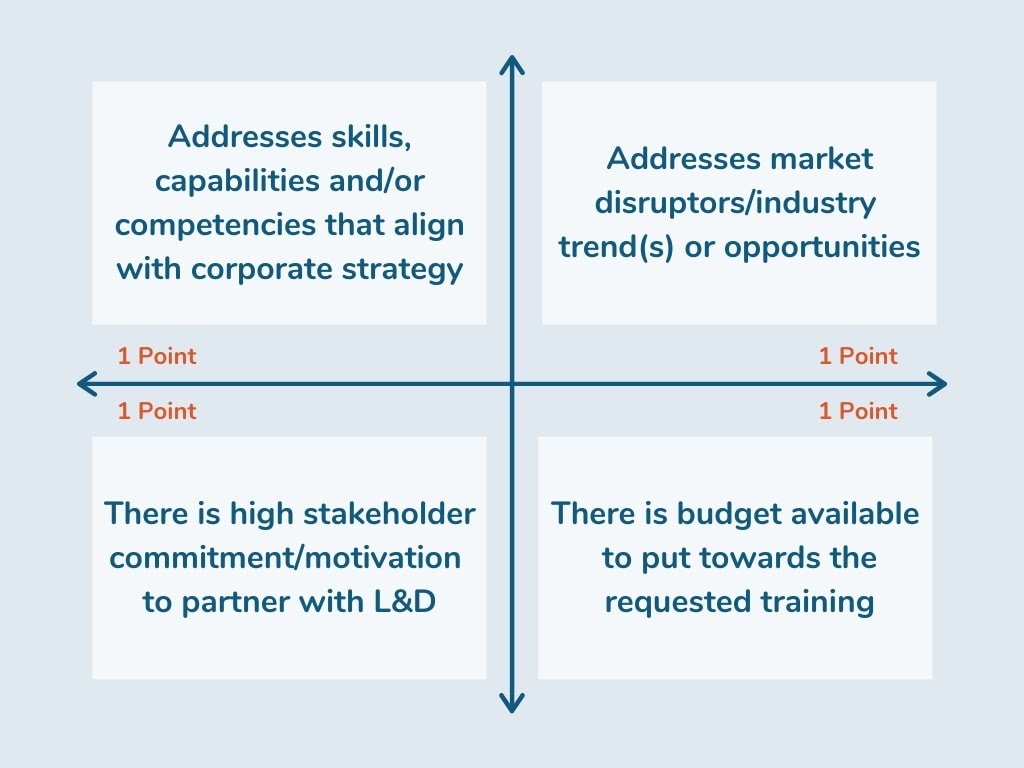
First, let’s examine each of those quadrants in more detail.
Your strategy acts as a guiding light, ensuring that you focus on activities that will help to drive your organization’s performance. As part of your departmental planning, you likely select key initiatives for the year that align with your corporate strategy. Assessing the alignment of each training request with strategic goals is a helpful way to ensure that the requests you prioritize are going to drive organizational results.
To support a workforce that must remain agile, training teams need to be constantly aware of the market forces affecting your organization. And it’s up to L&D to provide the knowledge, skills and behaviors employees need so they can adapt to these disruptors. This factor is important as it will help you align training intake with business performance.
Organizational will is needed to drive any true change or employee development. So there must be support for a project throughout its lifecycle – from development to implementation, and through to sustainability. That is why stakeholder commitment is a critical factor in determining if a request should be prioritized.
It is important to note that the role the stakeholder plays in the organization is also significant. Do they have the ability to champion at the executive level? The role of the stakeholder within your organization affects the weight you put on this category in your assessment. On the other hand, a “grassroots” movement for training where multiple employees or teams are requesting the same type of training should also be given significant weight.
Depending on the request, there may be a corresponding need for investment if the request is to be prioritized. Ask yourself if you require the following to deliver:
You could also extend this quadrant to wider resource availability. Smaller training teams only have so many hours to devote to different training projects. So you should carefully assess the capacity of your team and how much of your overall resources the request is likely to cost.
Once you’ve established how many points a request has earned, the path forward becomes clear.
The evaluation continuum applies an action to the value of the request as determined by the scorecard. That action may be to move forward immediately with fulfilling the training request. Or, to await further discussion with the requestor or the wider L&D team. The number of quadrants from the scorecard that apply to the request is a strong indication to either move forward or discuss the request further.
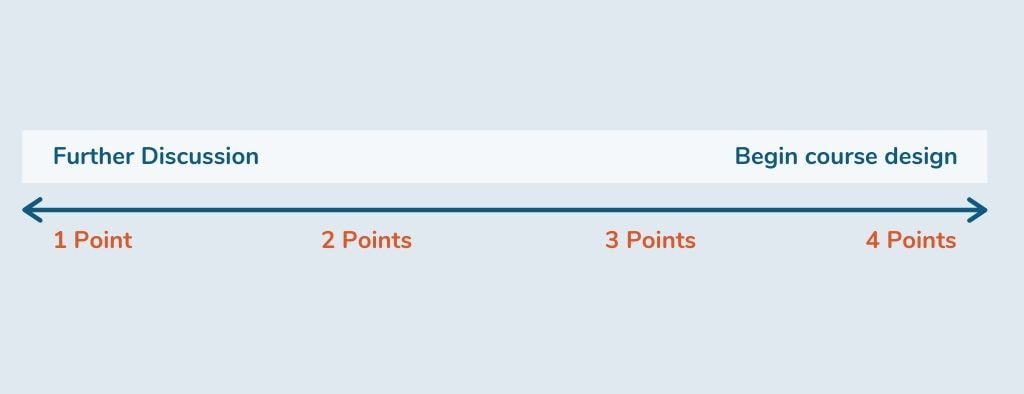
The examples of an Assessment Scorecard and Evaluation Continuum provided here are a good start. But you should also try to customize and develop them to align with your own organization and training team. For example, you might use slightly different quadrant labels in your Assessment Scorecard and provide higher weightings to one over another. On the Evaluation Continuum, you could then include a variety of steps to correspond with the score of each training request. These steps could include escalating the request to a more senior member of the team or scheduling a meeting with the requester.
By ensuring that your team’s process for assessing training requests is aligned with both your L&D strategy and the business needs that will drive your organization’s success, L&D can position itself as a group that provides invaluable consultation and support, and contributes to bottom line success.
Take control of your training intake process with a strategic approach to managing and prioritizing training requests. In this eBook, we share the components of a successfully
managed intake process and the tools you need to get you there.

What happens when the person who submitted a training request is so high up in the organization that you feel you can’t respond with a “No”? Or at least, not a straightforward one.
Consequently, corporate training teams can then feel stuck in the middle. You’re dealing with a training request that doesn’t make sense but feel compelled to fulfill it anyway because of the seniority on the other side of the emails. But it doesn’t have to be a total loss for the training team.
There can be a lot of political considerations when dealing with requests from executive management. But these quick tips will help you handle situations where the exec is demanding the impossible from the training team.
What do they really want?
If declining the request is impossible, explore the situation as deeply as possible. Try to uncover the real motivation behind the request.
It may then be possible to come up with another training idea that hits the mark for the exec, and for your learning outcomes.
Will this drain your resouces?
Executive are not “on the ground” in the organization. So, they may not realize how much of your precious resources this out-of-the-blue request will drain.
Executives speak in hard numbers and bottom line results. Therefore, try to show them the opportunity cost of fulfilling this request. They may begin to see your point of view.


What will be the short term impact?
Your exec may be keen for a quick win. But their request is interrupting your team’s carefully laid plans.
However, that doesn’t mean the request isn’t worth your time. Try to set aside the frustration and analyze the request on its own merit. Even a short term win is a win!
Are there political gains to be made?
Setting the requested training aside, take a moment to think about the other merits of fulfilling this request for a demanding executive.
Your team may be fighting for more resources or recognition. So this could be a great opportunity to earn it from those that matter.
You’ve designed and deployed your brand new training intake process. Your lovely new training request forms are sitting on the intranet and yet your team is still receiving informal email requests. So how can you make sure employees use the new process?
If employees and managers are still sending you emails, redirect them immediately to your new training request form. Advise them that training requests can only be processed once a form is filled out and submitted. Then, attach the form to your reply or send them the relevant link.
Promote your new training intake process as a strategic initiative. Show management and executives the value this can bring to employees and the organization as a whole. Earning their buy-in and getting their help in promoting the new process will encourage employees to follow suit.
We all know what it’s like to deal with a flood of emails. Frustration occurs when employees are waiting weeks or sending follow-up emails to check the status of their request. But with your new training intake process, processing and response times will be much quicker. So leverage this benefit when promoting the new training request form to the rest of your organization.
Your brand new training request form and intake process are no good unless people know about it. Rather than waiting for people to figure it, put some time into launching and marketing your new process internally. You may have an internal communications team that can help you out. But a good old fashioned email campaign and Intranet post will always do the trick.
Assessing and prioritizing training requests is all well and good when they are legitimate requests that answer a pressing business need. But any L&D pro can tell you that’s not always the case. So, how do you process and manage high volumes of requests when lots of them need to be declined?
There will be plenty of times when a training request lands on your desk and you will know immediately that it won’t be taken forward. For example, when you know training already exists for that topic, or the ask is too big for current resource levels.

As an internal service provider, employee engagement is a critical indication of success for the training team. Today’s workforce wants to learn, and training and development programs are an important factor in retaining top talent. So the last thing you want to do is discourage employees from engaging with your team or learning program.
Here are some top tips for rejecting training requests without making employees feel disillusioned with learning:
If you have to decline a training request, try not to use words with negative connotations such as “rejected”. Being overly dismissive or harsh in your response can have serious consequences for how your team is viewed by employees. Plus, it can have a negative impact on their motivation to learn or engage with training programs. So always thank the employee for their request and give a detailed explanation of the rejection.
Even if the request is misguided, ensure you highlight the L&D department’s reasons for not moving forward. Explain the high volumes of requests and the limitations of the training department’s current capacity for new course design. Always make sure the employee feel encouraged to submit further requests in the future.
Total rejection should never be the response to a training request. So try to offer the requestor a positive side step rather than completely rebuffing their desire to learn or improve. While you may not be engaging in new course design, try to point the employee towards existing resources (internal or external). Or encourage them to find another path such as:
Plus, if a departmental training budget is available to the requestor’s manager, they may be able to find an off-the-shelf course or external training solution that meets their needs.
Corporate training teams often rely heavily on Subject Matter Experts (SMEs) to help with training content. So why not encourage the requestor to identify an SME in their department who might be able to create the training they desire? L&D can even provide course templates and remain available as learning consultants to SMEs who are creating training. Also, by getting them involved, you retain oversight on training activities and no training request goes unanswered.

It’s true that training and performance are inextricably linked. But issues with performance due to environmental factors can never be solved with by the training department. Training and development can only assist with the learning and application of skills or knowledge. So if an employee is not performing because of personal issues, challenges in their working environment, or other factors, no amount of training is going to improve their performance.
However, learning teams rarely have this depth of insight into an employee or team performance when training requests get dropped into their inbox. So it’s important that you challenge this issue from the outset on your training request form. And if it’s not immediately apparent from the request form? Make sure to dig a little deeper during follow-up communications.
Some questions you can include to help you decide if it’s a training issue include:
Ultimately, you’re trying to figure out whether the employee “can’t” or they “won’t”. Employees who “won’t” are a lost cause for the training team. Their issues need to be identified or resolved by management.
However, just because it’s not a training issue doesn’t mean L&D should bow out completely. It’s still a good opportunity to provide value and help improve performance, which is a win for your team. L&D can offer management their expertise and support when identifying training needs and performance issues. Perhaps the solution is a job aid or a streamlined process. You’ll be saving managers and their employees tons of time rather than jumping straight into designing training that won’t work.

So you’ve standardized your approach to training intake. Now it becomes much easier to capture crucial information that can inform your strategic decision making.
L&D has been a little slower off the mark than other business functions when it comes to leveraging data for decision making. But capturing and measuring training intake metrics can give you invaluable insight.

Training intake analytics is the capturing of data related to your training intake process and measuring specific metrics over time using that data.
It can feel a little time consuming to capture all that information for each training request. But you’ll thank yourself later on. Here are just some of the ways having those insights can generate value for the L&D team:
Many training departments are working with a constant rotation of contractors, freelance designers, and other learning development roles. But when you can analyze your past training intake it becomes much easier to plan for the future and assign expected resources to specific upcoming training projects.
Prioritizing training requests is a process that can take a little bit of refining at first. But your training intake analytics can help you work it out over time. By looking back over different metrics, you may notice that a particular department has been neglected compared to others when it comes to getting their training requests accepted. Or perhaps you have seen a rise in high priority requests that need to be tackled.
When approaching executive management for more budget or resources, the first thing they will want to know is “why”? Having training intake metrics ready to go means you can show concrete figures about the internal demand for training and the gap between demand, current resources, and potential performance improvement as a result of those increased resources.
Simple as it may sound, we’ve spoken with many learning leaders who are not tracking training intake at all. But how can you assess the demand for training in your organization if you don’t know the volume of requests?
This basic metric encourages your learning team to start taking a unified approach and recording training requests in a central location.


You might know how many requests you receive, but can you easily find out how many of them were moved forward to course design in a given timeframe? What about the acceptance rate rising or falling over time?
Acceptance rate can tell you a lot about how your resources are matching up to overall demand.
Similarly, your rejection rate can tell you a lot about the landscape of training in your organization. But it’s also important to take a standardized approach to the reason for those rejections. Choose a few of the typical reasons your team is forced to decline training requests, such as “No capacity”, “Training already exists”, or “Not a training issue”, and start recording these reasons.
If you find that the majority of rejected training requests are due to “training already exists”, perhaps you need to reexamine how your learning programs are marketed to employees.


It’s important that no one gets left behind when it comes to corporate learning. Every employee stands to improve their performance and organizational contribution through up-skilling, cross departmental training, or any other kind of professional development.
Unfortunately, it’s often down to who shouts the loudest to win the attention of the training team, but if it’s the case that a couple of teams are being neglected, it’s something you should rectify.
If there’s one thing training departments strive for but struggle to attain, it’s linking their training efforts to bottom line results.
By tracking training requests according to revenue streams, it instantly becomes easier to track training efforts from beginning course design right down to performance impact.


If multiple teams, departments, or employees are requesting training across similar or identical topics, L&D can take the opportunity to consolidate the requests.
You’ll be able to create training that’s impacting multiple business functions and you’ll save time and resources.
Every employee or manager thinks their training request is “urgent” and “high priority”. But the learning pros in the organization know that not everything can be priority number one.
Once you’ve accepted a request, assign it a true priority level so you can keep track of what needs your attention the most.


Although many corporate training teams have been enjoying increased budgets and resources in recent years, there are only so many hours in the day and so many dollars in the budget.
For accepted requests, try to assign a realistic resource requirement for the potential course that will be developed. This metric will come in handy when requesting budgetary or staffing increases,
Resources per request will also help you in assessing the demand for training versus the current capacity of your training department.

Provide a standardized form, gather requirements, assess business impact and approve or decline requests with feedback to the requestor.
You’ll also get a centralized view of the status and volume of training requested for reporting and planning.
Resources for L&D Professionals

A curated, on-demand path for L&D and Talent leaders to modernize budgets, operations, and strategy using LearnOps. This webinar collection brings together leading CLOs, industry

Enterprise L&D teams manage hundreds of training requests, dozens of active projects, and limited team capacity. Without clear analytics, you’re flying blind. The problem isn’t

Talent and Learning and Development managers at enterprise organizations deal with real operational pressure. Most L&D teams handle more requests than they can take on,

A curated, on-demand path for L&D and Talent leaders to modernize budgets, operations, and strategy using LearnOps. This webinar collection brings together leading CLOs, industry

Enterprise L&D teams manage hundreds of training requests, dozens of active projects, and limited team capacity. Without clear analytics, you’re flying blind. The problem isn’t

A curated, on-demand path for L&D and Talent leaders to modernize budgets, operations, and strategy using LearnOps. This webinar collection brings together leading CLOs, industry
| Cookie | Duration | Description |
|---|---|---|
| cookielawinfo-checbox-analytics | 11 months | This cookie is set by GDPR Cookie Consent plugin. The cookie is used to store the user consent for the cookies in the category "Analytics". |
| cookielawinfo-checbox-functional | 11 months | The cookie is set by GDPR cookie consent to record the user consent for the cookies in the category "Functional". |
| cookielawinfo-checbox-others | 11 months | This cookie is set by GDPR Cookie Consent plugin. The cookie is used to store the user consent for the cookies in the category "Other. |
| cookielawinfo-checkbox-necessary | 11 months | This cookie is set by GDPR Cookie Consent plugin. The cookies is used to store the user consent for the cookies in the category "Necessary". |
| cookielawinfo-checkbox-performance | 11 months | This cookie is set by GDPR Cookie Consent plugin. The cookie is used to store the user consent for the cookies in the category "Performance". |
| viewed_cookie_policy | 11 months | The cookie is set by the GDPR Cookie Consent plugin and is used to store whether or not user has consented to the use of cookies. It does not store any personal data. |